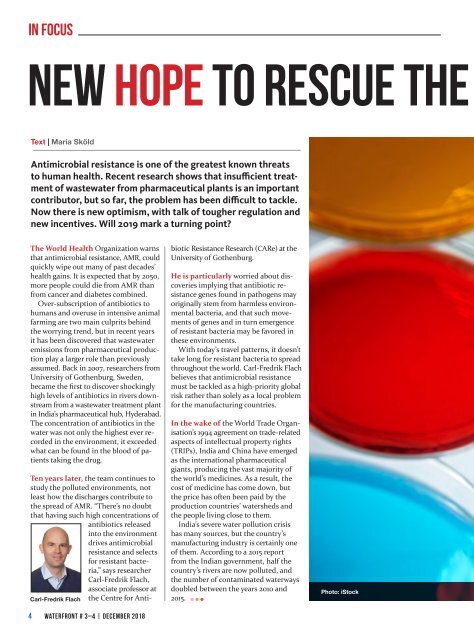Water Front #3-4 2018
Create successful ePaper yourself
Turn your PDF publications into a flip-book with our unique Google optimized e-Paper software.
In FOCUS<br />
NEW HOPE TO RESCUE THE<br />
Text | Maria Sköld<br />
Antimicrobial resistance is one of the greatest known threats<br />
to human health. Recent research shows that insufficient treatment<br />
of wastewater from pharmaceutical plants is an important<br />
contributor, but so far, the problem has been difficult to tackle.<br />
Now there is new optimism, with talk of tougher regulation and<br />
new incentives. Will 2019 mark a turning point?<br />
The World Health Organization warns<br />
that antimicrobial resistance, AMR, could<br />
quickly wipe out many of past decades’<br />
health gains. It is expected that by 2050,<br />
more people could die from AMR than<br />
from cancer and diabetes combined.<br />
Over-subscription of antibiotics to<br />
humans and overuse in intensive animal<br />
farming are two main culprits behind<br />
the worrying trend, but in recent years<br />
it has been discovered that wastewater<br />
emissions from pharmaceutical production<br />
play a larger role than previously<br />
assumed. Back in 2007, researchers from<br />
University of Gothenburg, Sweden,<br />
became the first to discover shockingly<br />
high levels of antibiotics in rivers downstream<br />
from a wastewater treatment plant<br />
in India’s pharmaceutical hub, Hyderabad.<br />
The concentration of antibiotics in the<br />
water was not only the highest ever recorded<br />
in the environment, it exceeded<br />
what can be found in the blood of patients<br />
taking the drug.<br />
4 WATERFRONT # 3–4 | december <strong>2018</strong><br />
Ten years later, the team continues to<br />
study the polluted environments, not<br />
least how the discharges contribute to<br />
the spread of AMR. “There’s no doubt<br />
that having such high concentrations of<br />
antibiotics released<br />
into the environment<br />
drives antimicrobial<br />
resistance and selects<br />
for resistant bacteria,”<br />
says researcher<br />
Carl-Fredrik Flach,<br />
associate professor at<br />
Carl-Fredrik Flach the Centre for Antibiotic<br />
Resistance Research (CARe) at the<br />
University of Gothenburg.<br />
He is particularly worried about discoveries<br />
implying that antibiotic resistance<br />
genes found in pathogens may<br />
originally stem from harmless environmental<br />
bacteria, and that such movements<br />
of genes and in turn emergence<br />
of resistant bacteria may be favored in<br />
these environments.<br />
With today’s travel patterns, it doesn’t<br />
take long for resistant bacteria to spread<br />
throughout the world. Carl-Fredrik Flach<br />
believes that antimicrobial resistance<br />
must be tackled as a high-priority global<br />
risk rather than solely as a local problem<br />
for the manufacturing countries.<br />
In the wake of the World Trade Organisation’s<br />
1994 agreement on trade-related<br />
aspects of intellectual property rights<br />
(TRIPs), India and China have emerged<br />
as the international pharmaceutical<br />
giants, producing the vast majority of<br />
the world’s medicines. As a result, the<br />
cost of medicine has come down, but<br />
the price has often been paid by the<br />
production countries’ watersheds and<br />
the people living close to them.<br />
India’s severe water pollution crisis<br />
has many sources, but the country’s<br />
manufacturing industry is certainly one<br />
of them. According to a 2015 report<br />
from the Indian government, half the<br />
country’s rivers are now polluted, and<br />
the number of contaminated waterways<br />
doubled between the years 2010 and<br />
2015.<br />
Photo: iStock


















